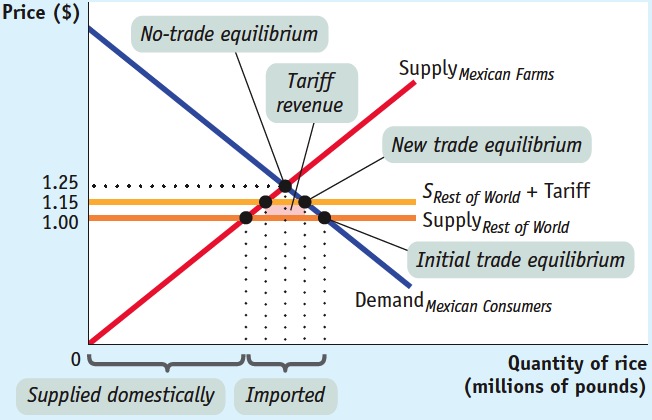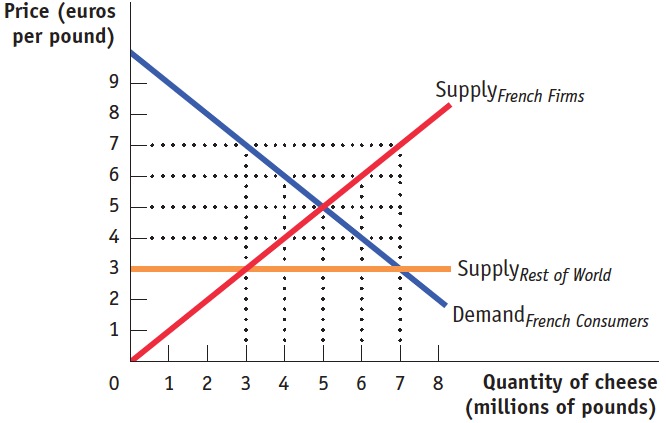Tackle the Test: Free-Response Questions
Question
Suppose that rice is traded in the world market at a price of $1 per pound, and that in the absence of trade, the equilibrium price of rice in Mexico is $1.25 per pound.
Draw a correctly labeled graph that shows the domestic supply and demand for rice in Mexico.
Label the no-
trade equilibrium and the trade equilibrium. Use labeled brackets to indicate the portions of the horizontal axis that represent
the quantity of rice imported at the world price.
the quantity of rice supplied domestically at the world price.
Suppose that Mexico imposes a $0.15 tariff per pound of imported rice.
Label the new trade equilibrium.
Shade the area that represents the total tariff revenue.
Rubric for FRQ 1 (6 points)

1 point: Graph with “Price” on the vertical axis, “Quantity of Rice” on the horizontal axis, downward-
sloping demand, upward- sloping supply, and the no- trade equilibrium 1 point: Horizontal rest-
of- world supply curve and trade equilibrium as shown in the figure 1 point: Correct indication of imported quantity
1 point: Correct indication of domestically supplied quantity
1 point: Horizontal rest-
of- world supply + tariff curve and new trade equilibrium as in the figure 1 point: Shaded area that represents tariff revenue as in the figure
Question
Suppose that cheese is traded in the world market at a price of €3 per pound. Assume that France has no trade barriers and has supply and demand curves for cheese as shown in the graph.

How much cheese does France import?
Suppose that France adopts an import quota of 2 million pounds of cheese.
What will the price be at the new trade equilibrium?
How much cheese will French suppliers provide domestically with the quota in place?
If France imposed a tariff instead of a quota to restrict cheese imports, a tariff of what amount per pound would result in imports of 2 million pounds of cheese?
Suppose that instead of any other trade restriction, France imposed a tariff of €4 per pound of cheese. How much cheese would France import? Explain. (6 points)
Rubric for FRQ 2 (6 points)
1 point: France imports 4 million pounds of cheese.
1 point: The price will be 4 euros per pound.
1 point: French suppliers will provide 4 million pounds of cheese domestically.
1 point: A tariff of 1 euro per pound would result in imports of 2 million pounds of cheese.
1 point: None
1 point: A tariff of 4 euros per pound of cheese would raise the import price up to 7 euros per pound. However, the domestic supply equals the domestic demand at a price of 5 euros per pound. As a result, there would be an excess supply of domestic cheese